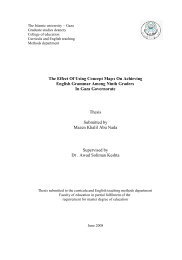A Study of Lean Construction Practices in Gaza Strip
A Study of Lean Construction Practices in Gaza Strip
A Study of Lean Construction Practices in Gaza Strip
Create successful ePaper yourself
Turn your PDF publications into a flip-book with our unique Google optimized e-Paper software.
2. Unnecessary material handl<strong>in</strong>g.<br />
3. Tradesmen slow/<strong>in</strong>effective.<br />
4. Far distance between place <strong>of</strong> work<strong>in</strong>g and storage.<br />
5. Poor distribution <strong>of</strong> materials <strong>in</strong> site.<br />
6. Lack <strong>of</strong> proper ma<strong>in</strong>ta<strong>in</strong>ed pathways.<br />
7. Difficulty <strong>in</strong> motion <strong>of</strong> worker <strong>in</strong> the site<br />
2.8.7 Over-process<strong>in</strong>g<br />
Over-process<strong>in</strong>g is un<strong>in</strong>tentionally do<strong>in</strong>g more process<strong>in</strong>g work than the customer<br />
requires <strong>in</strong> terms <strong>of</strong> product quality or features – such as polish<strong>in</strong>g or apply<strong>in</strong>g f<strong>in</strong>ish<strong>in</strong>g<br />
on some areas <strong>of</strong> a product that won’t be seen by the customer. Do<strong>in</strong>g more work tends<br />
to keep people “busy,” but adds no “value” such as writ<strong>in</strong>g a comprehensive legal<br />
agreement when a simple agreement would suffice, replac<strong>in</strong>g more parts than necessary,<br />
spend<strong>in</strong>g extra time do<strong>in</strong>g more analysis than is really necessary, unnecessary<br />
complexity.<br />
Over-process<strong>in</strong>g waste <strong>of</strong> construction <strong>in</strong> the <strong>Gaza</strong> <strong>Strip</strong> is due to:<br />
1. Conversion waste from cutt<strong>in</strong>g uneconomical shapes.<br />
2. Us<strong>in</strong>g excessive quantities <strong>of</strong> materials more than the required.<br />
3. Wrong handl<strong>in</strong>g <strong>of</strong> materials.<br />
4. Insufficient <strong>in</strong>structions about handl<strong>in</strong>g.<br />
5. Lack <strong>of</strong> workers or tradesmen or subcontractors’ skill.<br />
6. Difficulty <strong>in</strong> performance and pr<strong>of</strong>essional work.<br />
7. Interaction between various specialists.<br />
8. Us<strong>in</strong>g untra<strong>in</strong>ed labors<br />
28

















